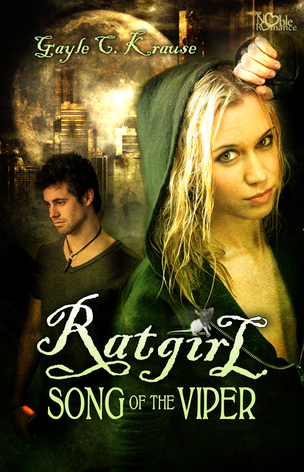I’d like to welcome Gayle C. Krause author of Ratgirl, Song of the Viper as a guest to my blog. Gail’s story is based on the classic tale of the Pied Piper of Hamelin and we’re going to discuss ‘reinventing’ a fairytale.
Thanks for having me as a guest on your blog, Roxanne. Fairy tales are one of my passions and I’m happy to discuss them with your readers today.
Fairy tales are once again leaving the nursery and reaching an older audience. Plots that emphasize the darker aspects of the stories are becoming popular in movies, Hansel and Gretel, Witch Hunters for example. Gayle, when approaching a classic tale and reinventing it for a modern audience what do you look for?
For me, personally, I am drawn to the darker organic fairy tales. By this, I mean the story has sinister, intriguing aspects to it, which can be exploited to write a gritty, heroic rendition.I think there’s more room to elaborate on the less obvious aspects of the fairy tale, and weave a story today’s teen would be interested in.
What drew you to the Pied Piper story?
The darkness, the rats, and the oppression the villagers suffered at the hands of the corrupt mayor and his corporation, and a strong female character to battle them.
Fairytales have obviously stood the test of time. Like myths, they are passed down from generation to generation. What do you feel allows a fairy tale to appeal to audiences over such a long span of time?
For a story to hold a child’s attention it must be entertaining, and arouse curiosity, but most of all it must stimulate the imagination. Actually, that’s the exact same criteria needed to make a YA novel successful.
Fairy tales were originally told around the hearth at the end of a long day. However, the stories weren’t the tales of magic and mayhem we know today. They were actually gossip of the town or village, told to teach a child lessons on the meaning of life. A brother and sister abandoned in the woods by a father. A young girl tricked by a man, who tries to lure her into a sexual relationship. A loving daughter turned into the servant of her own home, by a jealous stepmother. What better fantasy than to embellish the true facts of life?
Today, fairy tales are still told as a way for children to distinguish between fantasy and reality. By dealing with the universal problems a child must face, fairy tales encourage psychological development and emotions, that hopefully lead to wise decisions on the child’s part.
How close do you think a reinvented fairytale should remain to the original?
There are two points of view on this question, and perhaps the definitions lie in how we describe the story.
One is a retelling. In this version of the fairy tale the plotline is closely followed. It may be expanded into a YA or MG novel and include new information, but essentially it remains the same story as the original.
The other is an adaptation, where the text is given modern tools and expressions and the story is loosely based on the original. Stories with strong female characters, or weak female characters, who can be re-invented as strong, to take charge of their lives, makes manipulating the traditional tales fun and a great creative outlet for the author or screenwriter. Thus, the current influx of reinvented fairy tales for the big screen.
Do you have a favorite retold fairytale?
Yes. My favorite fairy tale as a child was The Twelve Dancing Princesses. Juliet Marillier’s first YA novel, Wildwood Dancing, incorporates the story of The Frog Prince and The Twelve Dancing Princesses with the realm of Otherworld creatures.
And they all lived happily ever after . . . fairytale twists often pick up the original story after the closing scene and question how true ‘happily ever after’ is. Does Ratgirl take us further than the original story?
Ratgirl sets the stage for ‘happily ever after,’ but to actually see the result, I’d have to write the sequel. The story ends with the characters and setting in place, but the time has not yet arrived to see if they in fact do live ‘happily ever after.’
If the idea for a sequel that’s floating around in my head comes to fruition, I’m thinking it won’t be all that happy unless Jax or Andy Stone take a stance against the evil that will follow them to the New Continent.
Ratgirl will be available at all retail outlets February 5, 2013.
Thanks for having me as a guest on your blog, Roxanne. Fairy tales are one of my passions and I’m happy to discuss them with your readers today.
Fairy tales are once again leaving the nursery and reaching an older audience. Plots that emphasize the darker aspects of the stories are becoming popular in movies, Hansel and Gretel, Witch Hunters for example. Gayle, when approaching a classic tale and reinventing it for a modern audience what do you look for?
For me, personally, I am drawn to the darker organic fairy tales. By this, I mean the story has sinister, intriguing aspects to it, which can be exploited to write a gritty, heroic rendition.I think there’s more room to elaborate on the less obvious aspects of the fairy tale, and weave a story today’s teen would be interested in.
What drew you to the Pied Piper story?
The darkness, the rats, and the oppression the villagers suffered at the hands of the corrupt mayor and his corporation, and a strong female character to battle them.
Fairytales have obviously stood the test of time. Like myths, they are passed down from generation to generation. What do you feel allows a fairy tale to appeal to audiences over such a long span of time?
For a story to hold a child’s attention it must be entertaining, and arouse curiosity, but most of all it must stimulate the imagination. Actually, that’s the exact same criteria needed to make a YA novel successful.
Fairy tales were originally told around the hearth at the end of a long day. However, the stories weren’t the tales of magic and mayhem we know today. They were actually gossip of the town or village, told to teach a child lessons on the meaning of life. A brother and sister abandoned in the woods by a father. A young girl tricked by a man, who tries to lure her into a sexual relationship. A loving daughter turned into the servant of her own home, by a jealous stepmother. What better fantasy than to embellish the true facts of life?
Today, fairy tales are still told as a way for children to distinguish between fantasy and reality. By dealing with the universal problems a child must face, fairy tales encourage psychological development and emotions, that hopefully lead to wise decisions on the child’s part.
How close do you think a reinvented fairytale should remain to the original?
There are two points of view on this question, and perhaps the definitions lie in how we describe the story.
One is a retelling. In this version of the fairy tale the plotline is closely followed. It may be expanded into a YA or MG novel and include new information, but essentially it remains the same story as the original.
The other is an adaptation, where the text is given modern tools and expressions and the story is loosely based on the original. Stories with strong female characters, or weak female characters, who can be re-invented as strong, to take charge of their lives, makes manipulating the traditional tales fun and a great creative outlet for the author or screenwriter. Thus, the current influx of reinvented fairy tales for the big screen.
Do you have a favorite retold fairytale?
Yes. My favorite fairy tale as a child was The Twelve Dancing Princesses. Juliet Marillier’s first YA novel, Wildwood Dancing, incorporates the story of The Frog Prince and The Twelve Dancing Princesses with the realm of Otherworld creatures.
And they all lived happily ever after . . . fairytale twists often pick up the original story after the closing scene and question how true ‘happily ever after’ is. Does Ratgirl take us further than the original story?
Ratgirl sets the stage for ‘happily ever after,’ but to actually see the result, I’d have to write the sequel. The story ends with the characters and setting in place, but the time has not yet arrived to see if they in fact do live ‘happily ever after.’
If the idea for a sequel that’s floating around in my head comes to fruition, I’m thinking it won’t be all that happy unless Jax or Andy Stone take a stance against the evil that will follow them to the New Continent.
Ratgirl will be available at all retail outlets February 5, 2013.


 RSS Feed
RSS Feed
